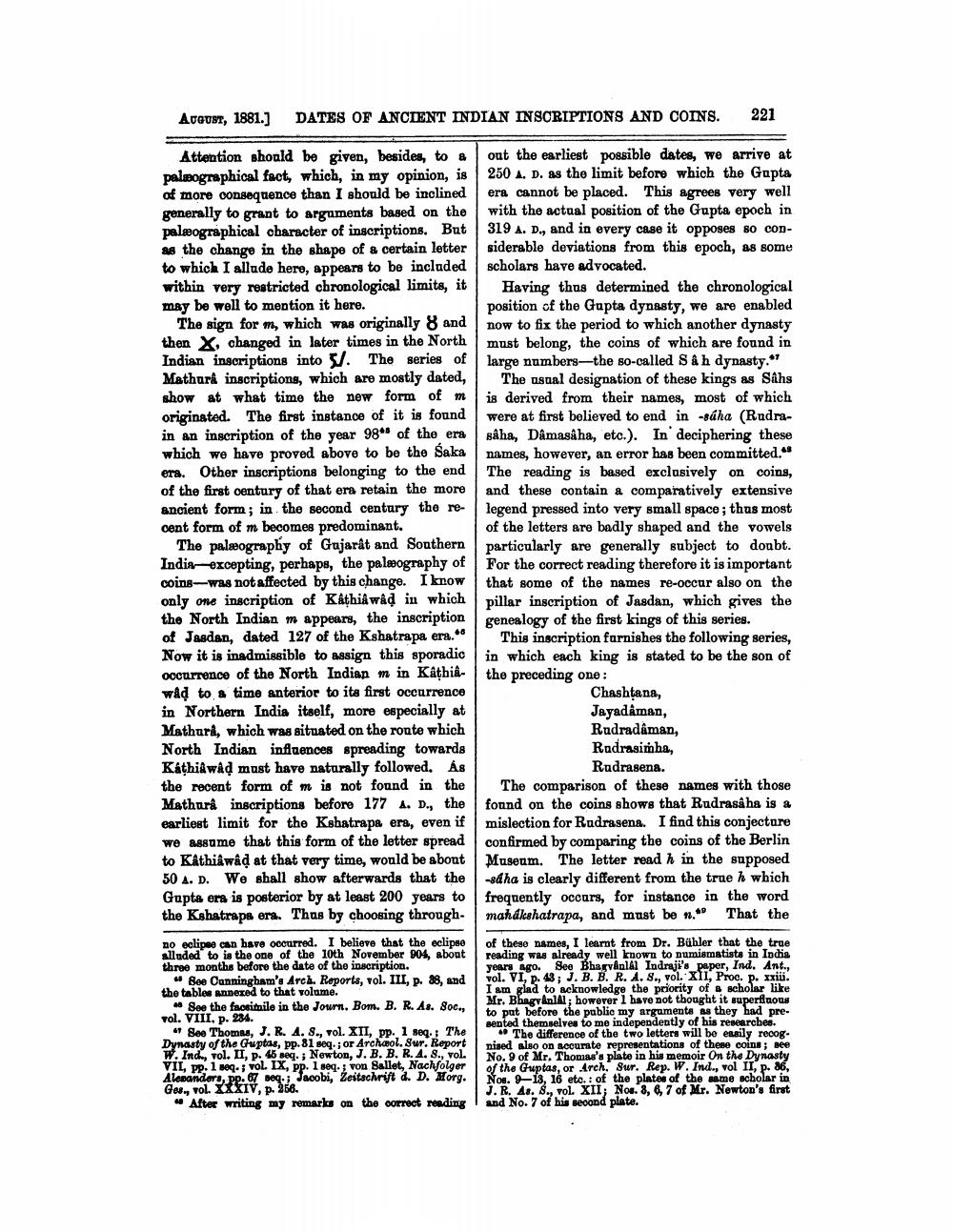________________
Avqust, 1881.]
DATES OF ANCIENT INDIAN INSCRIPTIONS AND COINS.
221
Attention should be given, besides, to &
out the earliest possible dates, we arrive at palmographical fact, which, in my opinion, is 250 A. D. As the limit before which the Gupta of more consequence than I should be inclined era cannot be placed. This agrees very well generally to grant to arguments based on the with the actual position of the Gupta epoch in palæographical character of inscriptions. But 319 A. D., and in every case it opposes so conas the change in the shape of a certain letter siderable deviations from this epoch, as some to which I allude here, appears to be included scholars have advocated. within very restricted chronological limits, it
Having thus determined the chronological may be well to mention it here.
position of the Gupta dynasty, we are enabled The sign for m, which was originally 8 and now to fix the period to which another dynasty then X, changed in later times in the North must belong, the coins of which are found in Indian inscriptions into . The series of large numbers-the so-called Så h dynasty." Mathura inscriptions, which are mostly dated, The asual designation of these kings as Sahs show at what time the new form of m is derived from their names, most of which originated. The first instance of it is found were at first believed to end in -sáha (Rudrain an inscription of the year 98 of the era såha, Damasäha, etc.). In deciphering these which we have proved above to be the Saka names, however, an error has been committed." era. Other inscriptions belonging to the end The reading is based exclusively on coins, of the first oentury of that era retain the more and these contain a comparatively extensive ancient form ; in the second century the re- legend pressed into very small space; thus most oent form of m becomes predominant.
of the letters are badly shaped and the vowels The palæography of Gujarat and Southern
particularly are generally subject to doubt. India-excepting, perhaps, the palæography of For the correct reading therefore it is important coins-was not affected by this change. I know that some of the names re-occur also on the only one inscription of Kathiwad in which
pillar inscription of Jasdan, which gives the the North Indian m appears, the inscription genealogy of the first kings of this series. of Jasdan, dated 127 of the Kshatrapa era." This inscription furnishes the following series, Now it is inadmissible to assign this sporadic in which each king is stated to be the son of occurrence of the North Indian m in Kathiê-l the preceding one: wad to a time anterior to its first occurrence
Chashtana, in Northern India itself, more especially at
Jayadaman, Mathurd, which was situated on the route which
Rudradâman, North Indian influences spreading towards
Radrasimha, Kathiểwad must have naturally followed. As
Radrasena. the recent form of m is not found in the The comparison of these names with those Mathara inscriptions before 177 1. D., the found on the coins shows that Rudrasaha is a earliest limit for the Kshatrapa era, even if mislection for Rudrasena. I find this conjecture We assume that this form of the letter spread confirmed by comparing the coins of the Berlin to Kathiawad at that very time, would be about Museum. The letter read h in the supposed 50 A. D. We shall show afterwards that the -8dha is clearly different from the true h which Gupta era is posterior by at least 200 years to frequently occurs, for instance in the word the Kshatrapa era. Thas by choosing through- | mahdkshatrapa, and must be *.* That the no eclipe can have occurred. I believe that the eclipse of these names, I learnt from Dr. Bühler that the true alluded to is the one of the 10th November 904, about reading was already well known to numismatista in India three months before the date of the inscription.
years ago. See Bhagvånlal Indraji's paper, Ind. Ant., See Cunningham's Arch. Reports, vol. III, p. 88, and vol. VI, p. 43; J. B. B. R. A. S., vol. XII, Proc. p. xxiü. the tables annexed to that volume.
I am glad to acknowledge the priority of a scholar like * See the facsimile in the Journ. Bom. B. R.As. 8oc.,
Mr. Bhagvanlal, however I have not thought it superfluous
to pat before the public my argamente as they had prevol. VIII, p. 284.
sented themselves to me independently of his researches. " See Thomas, J. R. A. 8., vol. XII, pp. 1 seq., The The difference of the two letters will be easily recog. Dynasty of the Guptas, pp. 81 seq.; or Archaol. Sur. Report
nised also on accurate representations of these coins; see W. Indh, vol. II, p. 45 seq. ; Newton, J. B. B. R. A. 8., vol.
No. 9 of Mr. Thomas's plate in his memoir on the Dynasty VIL, pp. 1 seq. ; vol. IX, pp. 1 seq. von Ballet, Nachfolger
of the Guptas, or Arch. Sur. Rep. W. Ind., vol II, p. 86, Alepandors, pp. 67 seq. Jacobi, Zeitschrift d. D. Morg. Nos. 9-18, 16 etc.: of the plates of the same scholar in Ges., vol. XXXIV, p. 356.
J.R. 43. 8., vol. XII; Nos. 3, 6, 7 of Mr. Newton's first "After writing my remarks on the correct reading and No. 7 of his second plate.




